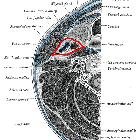head and neck anatomy
Head and neck anatomy is important when considering pathology affecting the same area. In radiology, the 'head and neck' refers to all the anatomical structures in this region excluding the central nervous system, that is, the brain and spinal cord and their associated vascular structures and encasing membranes i.e. the meninges. Many pathologies are confined to a particular area of the head and neck making separation of this section of the human body exceptionally useful.
This anatomy section promotes the use of the Terminologia Anatomica, the international standard of anatomical nomenclature.
Superficial head and neck
Deep head and neck
The deep anatomy is separated by fascial planes into seven deep compartments of the head and neck:
- pharyngeal (superficial) mucosal space
- parapharyngeal space
- parotid space
- carotid space
- masticator space
- retropharyngeal space
- perivertebral space
Many of the disease states that affect the deep structures of the head and neck are confined to one compartment. However, there are some diseases that are considered trans-spatial diseases.
Surgical triangles of the neck
There are several triangles of the neck that are more surgically focused, first described from early dissection-based anatomical studies which predated cross-sectional anatomical description based on imaging:
Siehe auch:
- carotid space
- parotid space
- deep compartments of the head and neck
- masticator space
- Retropharyngealraum
- superficial mucosal space
- prevertebral space
- Parapharyngealraum
und weiter:

 Assoziationen und Differentialdiagnosen zu anatomy of the head and neck:
Assoziationen und Differentialdiagnosen zu anatomy of the head and neck:


